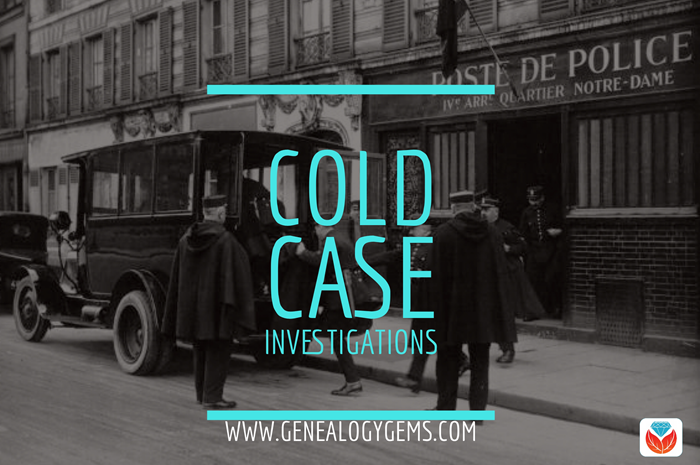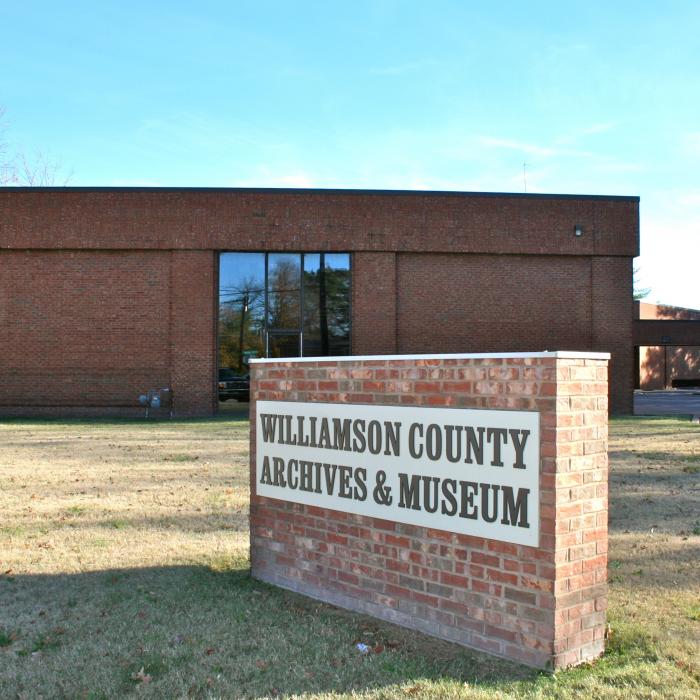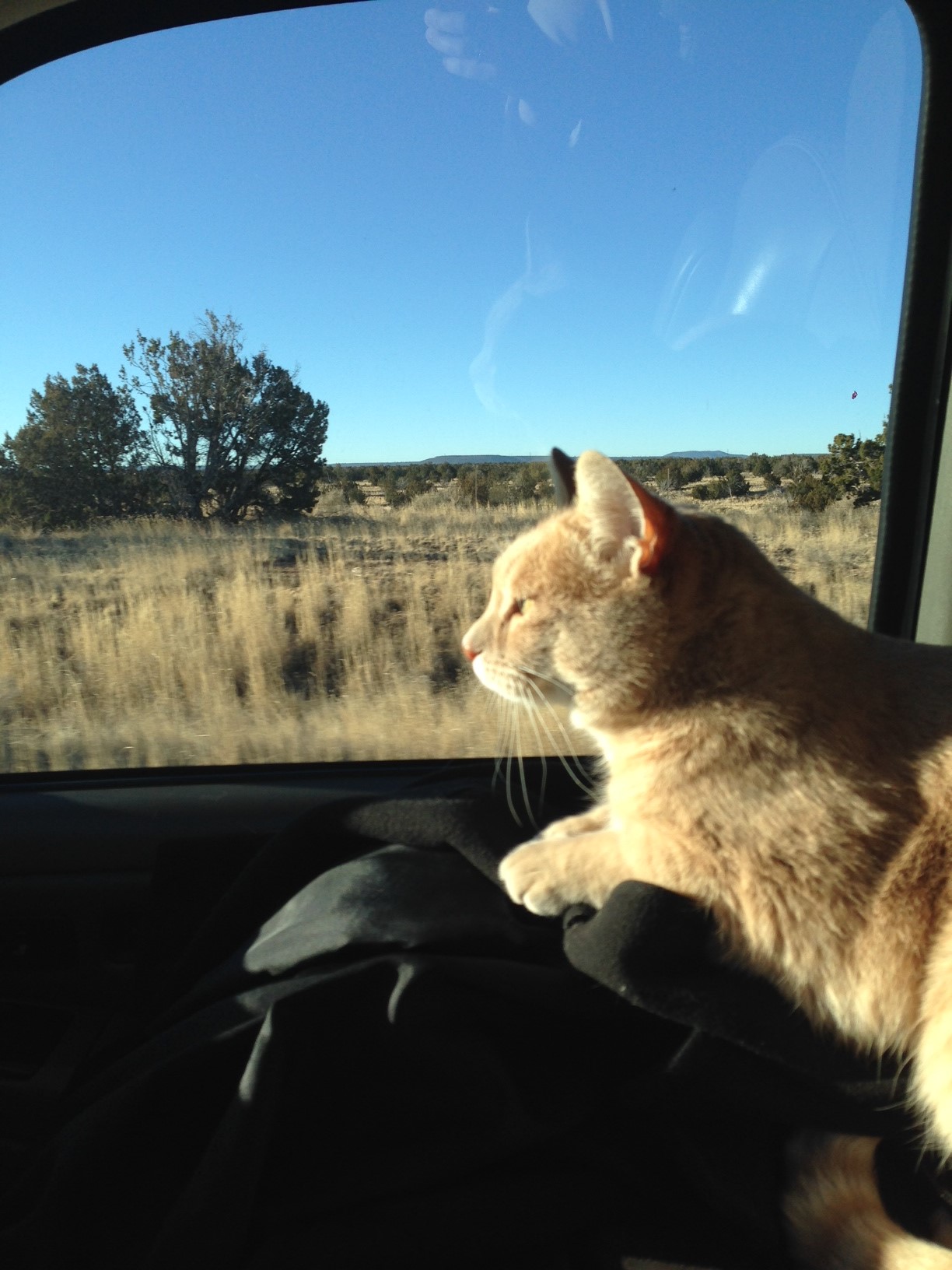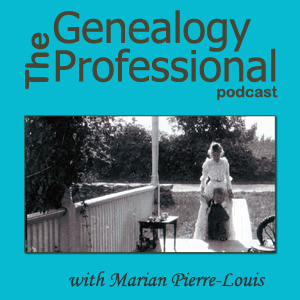by Lisa Cooke | May 3, 2014 | 01 What's New, Brick Wall, Google, Inspiration
Cold Case files are as common in genealogy as they are in criminal investigations. So it seemed a no brainer to me that family historians could  incorporate some of the same techniques that cold case investigators use. And that is how my presentation How to Reopen and Work a Genealogical Cold Case was born.
incorporate some of the same techniques that cold case investigators use. And that is how my presentation How to Reopen and Work a Genealogical Cold Case was born.
I recently brought this exciting hour to the folks at the Williamson County Texas Genealogical Society and they embraced it with open arms. Eyes were lighting up, and there was excitement in the air at the prospect of pulling some of those dusty old brick walls off their genealogical office shelves. I warned the group that they would be blaming for a sleepless night that night as they burned the midnight oil putting the tips to work. And as always, I encourage them to let me in on their successes by dropping me an email. I never cease to be amazed at what my wonderful audiences accomplishes!
An email from Teresa Hankins of Round Rock, TX landed in my inbox the very next morning, and her message was inspiring:
 “I attended your lecture on Genealogical Cold Cases at the Williamson County Genealogical Society’s meeting just last night. It was late when I got home, but I wanted to check out some of your suggestions on cracking hard cases. I was particularly interested in Google Books, as I had just recently discovered it, but hadn’t used it much.
“I attended your lecture on Genealogical Cold Cases at the Williamson County Genealogical Society’s meeting just last night. It was late when I got home, but I wanted to check out some of your suggestions on cracking hard cases. I was particularly interested in Google Books, as I had just recently discovered it, but hadn’t used it much.
The Case: My 2nd great-grandfather, Joshua, was too young to serve in American Civil War, but he had nine brothers who did serve. These brothers are what first prompted my interest in genealogy, and I’ve spent untold hours reconstructing their movements and histories.
One of the most poignant stories is that of David, the youngest of the nine. He couldn’t have been more than 17 years old when he joined the Union regiment. He was wounded at the Battle of Lone Jack, discharged, and then married Margaret, a young lady from a neighboring farm. They had one child, named Thomas, and then David was murdered by bushwhackers. His young bride remarried and had two more children before she, too, passed away at a young age. My unsolvable case was with Thomas, son of David and Margaret, who seemed to vanish from history. He lost his father when he was an infant, his mother when he was about 12, and I wanted to know what happened to him!
 Like all good genealogists, I was only going to research a little before going to bed. I wanted to play around on Google Books and see how the searches worked. I typed in a few key words that were unsuccessful before settling on a group of books based on Benton County, Missouri, which is where most of my ancestors in this line resided. I was just clicking on a book and searching for the surname, not looking for anything in particular. I only wanted to see what would come up and how the search engine worked. The next thing I know, I am looking at a record from the Supreme Court of Missouri, regarding some sort of land dispute. There are all the names involved, Thomas, his two half siblings, another family that I know are neighbors and relatives! I now know the month and year that Thomas died. I know that he sold some land one of his uncles. He was living there among family and friends, and though he, too, died young, at least I know what happened! This has opened up a cold case, and now it is on fire with new leads. I can’t wait to see what else I can dig up on Google Books!
Like all good genealogists, I was only going to research a little before going to bed. I wanted to play around on Google Books and see how the searches worked. I typed in a few key words that were unsuccessful before settling on a group of books based on Benton County, Missouri, which is where most of my ancestors in this line resided. I was just clicking on a book and searching for the surname, not looking for anything in particular. I only wanted to see what would come up and how the search engine worked. The next thing I know, I am looking at a record from the Supreme Court of Missouri, regarding some sort of land dispute. There are all the names involved, Thomas, his two half siblings, another family that I know are neighbors and relatives! I now know the month and year that Thomas died. I know that he sold some land one of his uncles. He was living there among family and friends, and though he, too, died young, at least I know what happened! This has opened up a cold case, and now it is on fire with new leads. I can’t wait to see what else I can dig up on Google Books!
Thank you for all the useful information you shared. I learned so much. I can’t wait to try out your other suggestions. You said to send you an email if we cracked a cold case, and that is what I’m doing. Have a blessed day!”
Well, I feel blessed every time I hear from my fabulous students / listeners / readers! I’m a lucky girl!
And I received one more blessing in Round Rock: At long last I finally got to meet my cousin Carolyn. You “met” Carolyn on the free Family History: Genealogy Made Easy podcast episodes about contacting living relatives (see below for links.) Carolyn and I have been collaborating online for nearly ten years on our family history (her mother is my Grandmother’s sister) but we never had the opportunity to meet in person until now. She’s as sweet and warm as she is on the phone – it’s not wonder she has such great success reaching out to family relations.
It’s wonderful to hear from folks about how they have benefited from something I’ve shared, but I could write volumes on the blessings I’ve received in this job that I love.
Heritage Quilts Video with Carolyn: featuring a quilt in our family. Each block features one of our female ancestors.
 Episode 14: How to Contact Long-Lost Relatives
Episode 14: How to Contact Long-Lost Relatives
Connecting with someone who knows about our ancestors can really boost our research results—and even create new relationships among living kin. But it’s not always easy to send that first email or make that first call. In this episode, we chat with my cousin, Carolyn Ender, who has mastered the art of “genealogical cold calling” by conducting hundreds of telephone interviews. She has a knack for quickly connecting with folks she doesn’t know over the telephone in ways that put them at ease and bring to light the information that she’s looking for.
Episode 15: More Tips for Contacting Distant Relatives
In this episode we talk more about “genealogical cold calling” with my cousin, Carolyn Ender, who has conducted hundreds of telephone interviews. Relationships are key to genealogical success and by following 14 genealogical cold calling strategies you will find your research relationships multiplying.

A one hour video of Lisa’s class on Genealogical Cold Cases is part of Genealogy Gems Premium Membership. Click here to become a Member.
by Lisa Cooke | Jan 31, 2014 | 01 What's New, Genealogy Gems Podcast
It was a daunting thought! I had over 1650 miles to drive last weekend to make the move from California to Texas. And I’m notorious for getting sleepy on car rides.
I had over 1650 miles to drive last weekend to make the move from California to Texas. And I’m notorious for getting sleepy on car rides.
My husband was driving the moving van, so I needed to drive the suburban on my own. How was I going to keep myself alert and occupied?
And then it hit me (the podcaster): Listen to podcasts! <SMACK> I coulda had a V8!
I loaded my iPad and smart phone with dozens of various podcast episodes. I ended up learning a ton, and having a grand time, with no zzzzzs!
I often hear from folks “I just can’t seem to find time to listen, or do half the other things I need to do.” But you don’t have to drive 1650 miles to make time to listen to podcasts.
(By the way, I’ve heard from many of you asking if my cat Ginger survived the trip since in our last Genealogy Gems e-newsletter you saw how she had packed herself. Not only did she survive it, she became queen of the car. Here she is perched on the front passenger seat taking in the New Mexico landscape!)
 Think You Don’t Have Time to Listen to the Genealogy Podcasts? Here are 5 Occasions When You Can, and Should, Listen:
Think You Don’t Have Time to Listen to the Genealogy Podcasts? Here are 5 Occasions When You Can, and Should, Listen:
1. When you are exercising
Many of my listeners are shedding pounds and getting fit while listening to the show. One listener told me she lost over 100 pounds listening to genealogy podcasts thanks to a waterproof mp3 player and her local swimming pool! And like many listeners, Roger in Utah takes the show on his daily walks, enjoying two of his favorite activities simultaneously: walking and genealogy.
2. When you are driving
Here’s an example of how one Genealogy Gems listener, gets into gear: “I recently stumbled upon your podcasts and I must say wow! They were awesome. I listened to episode 1-56 in 10 days. I drive a truck for a living so I have plenty of time to listen.
I was on a genealogy message board and someone mentioned genealogy podcast. I knew my wife had a ipod shuffle lying around so I said hey, let me see if I can find some genealogy podcasts on iTunes. I typed in ‘genealogy’ and up popped a few different choices. I downloaded most of them but yours just caught my attention. Your enthusiasm for genealogy clearly shows through in your podcasts. Your “bubbley” attitude, if I may, is pleasant to listen to and your podcasts are full of history.
I found myself enthralled with the story of the Lennon sisters and their tragic loss of their father and the lady talking about the quilts. Please don’t tell anyone I said that as my truck driving colleagues would razz me to no end if they heard me say that. I can’t count how many times I had to pull my truck over to write down a web site you mentions or a tip you gave. Then I get home and check out the show notes for photos and other goodies. So, just a note to say thanks for helping my day go by and for the great gems that I can’t wait to use when I get home.”
3. When you are cleaning and organizing your home office / genealogy space
If you sit down just once a week and sort and clean while you listen to one episode (usually about 45 mintes) you not only be well-informed but your genealogy space will be ready for greater success! (Come on, you know you need to!)
4. When you are scanning old family photos
We all have piles of old photos and documents that need scanning. Do double duty by scanning while you listen. Check out Genealogy Gems Podcast Episode 57 for more on photo scanning and preservation with Sally Jacobs, the Practical Archivist.
When you are doing housework, yard work, or working at the office
Genealogy Gems listener Bryan writes: “Whenever I am doing housework, yard work or driving in the car I am listening to you. I have been listening to you for weeks and I am still 3 years behind…I am enjoying these podcast as they are entertaining and informative. I am eagerly trying to listen at every opportunity so that I can get current.”
And Line in Denmark writes: “I recently stumbled over one of your Podcasts, and after listening to just a few episodes I was hooked.I listen to them every day at work. Some times even twice. Extra benefit: I´m shaping up my English!
And where there’s a will, there’s a way! Here are 5 Ways to Listen:
- On your computer (through this website)
- On your iPad or Tablet (via the Genealogy Gems App)
- On your smartphone (via the Genealogy Gems App)
- MP3 Player (Load it up with downloaded episodes from the website, or through iTunes)
- Burned CD (Use iTunes to burn the downloaded MP3 files to CD and play it on your stereo)
Next read: Just How Many (and Who) are Subscribing to Podcasts?

by Lisa Cooke | Oct 22, 2013 | Ancestry, Beginner, Family History Podcast, FamilySearch, Records & databases, Research Skills
 Tune in Tuesday: The Family History: Genealogy Made Easy Podcast
Tune in Tuesday: The Family History: Genealogy Made Easy Podcast
Published October 15, 2013
by Lisa Louise Cooke
[display_podcast]
Download the Show Notes for this Episode
Welcome to this step-by-step series for beginning genealogists—and more experienced ones who want to brush up or learn something new. I first ran this series in 2008. So many people have asked about it, I’m bringing it back in weekly segments.
Episode 3: Working Backward and the SSDI
In our first segment in this episode my guest is Miriam Robbins Midkiff, a well-known genealogy blogger and teacher. She shares her best research tips, what motivates her to delve into her family history and how that discovery has enriched her life.
Then in our second segment we answer the question, “Why do we work backwards in genealogy?” and then fire up the Internet and go after your first genealogical record. Below, find current links to the record sources I talk about in the show. Also, when I recently checked, the Social Security Death Index was no longer free at WorldVitalRecords as I mention in the podcast and some of the site features I mention may have changed. I’ve given you links below to more options for searching, including plenty of FREE options!
Working Backward
When it comes to tracing your family history, there are standard methods that will help you build a solid family tree. Starting with yourself and working backwards is a cornerstone of genealogical research. It will be tempting to start with a great grandparent that you just got some juicy information on after interviewing Aunt Martha, but resist the temptation to start with that great grandparent, and go back to the beginning – and that’s YOU!
There’s a very good reason why working backward is so effective. Let’s say you have filled in info on yourself, and then recorded everything about your parents and now it’s time to work on one of your grandfathers and all you have is the date he died and the date he was born. If you are lucky enough to have his birth date and birthplace and you get his birth certificate it will tell you who his parents were, but it can’t predict his future can it? Where he went to school, where he lived over the years, etc. Documents can only tell you what has occurred in the past, not what will occur in that person’s future.
But if you get his death certificate it will give you key information at the end of his life that can lead you to the various events throughout his life. If you don’t have his birthdate and birthplace, you’ll probably find it on the death certificate. It will also likely name his parents and his spouse. A birth record can’t tell you who he will marry, but a death record can tell you who he did marry. You can start to see how starting at the end of someone’s life and working backwards will be the most efficient and accurate way to research.
Records are like the bread crumb trail of your family tree! If you don’t work systematically backwards, it will be very easy to miss a crucial piece of evidence, and you might end up relying on guesswork and end up building a false history on it. Believe me you don’t want to invest time in a tree that you’re going to have to chop down and replant!
So now that you understand and are committed to following this cornerstone concept of systematically starting with yourself and working backwards, it’s time to fire up the Internet and put it into practice by finding your first record. What type of record will we be looking for? A death record of course!
Is one of your parents deceased? If so, you’re going to start with them. If they are still living, and you’ve got their information entered into your genealogy database choose one of their parents, your grandparents, who is deceased – or if you’re lucky enough to be starting at a young age you may have to go back to a deceased great grandparent! (And good for you for starting now while you’re young!)
The SSDI
Chances are the person that you’ve chosen, for this example let’s say it’s your grandfather, he most likely had a social security card. And there is a wonderful free database online in the United States called the Social Security Death Index, what is commonly referred to as the SSDI, that you can use to find that grandparent.
In 1935 the Social Security Act was signed into law by President Franklin Roosevelt, and consequently more than thirty million Americans were registered by 1937. Today, the Death Master File from the Social Security Administration contains over 89 million records of deaths that have been reported to the Social Security Administration and they are publicly available online.
Most of the information included in the index dates from 1962, although some data is from as early as 1937. This is because the Social Security Administration began to use a computer database for processing requests for benefits in 1962. Many of the earlier records back to 1937 have not been added.
The SSDI does not have a death record for everyone; and occasionally you may find an error here and there if something was reported inaccurately, but overall it’s a terrific resource! As with all records it provides clues that you should try to verify through an additional record source.
There are many websites that feature this database, as seen in the UPDATED links below. This database is free at most sites, even sites that charge for access to other data.
On the Search page, enter your grandparent’s given name which is their first name, the family name which is their last name or surname, the place of their death – this could just be the state – and the year they died, and click the Search button. Hopefully you will get back a result that includes your grandparent.
Now remember you’re looking at an index, not an original record or primary source. We talked about sources in Episode 2. A primary source is a document that was created at the time of the event by an authoritative source, usually someone with direct personal knowledge of the event that’s being documented, like a death certificate is completed at the time of death by the attending physician. These are the best and usually most accurate types of sources you can find. And that’s what we want!
The really key information in this search result is the county information. In order to get an original death certificate which would be your primary source you have to know which county they died in. You may already know that for your grandparent, but keep this in mind because the further back we go, the more crucial it will be to know the county involved since that’s where death certificates are recorded.
By any chance did your grandparent not show up in the results even though you know they worked after 1937 when the Social Security got rolling, and you know they have passed away? Don’t fret – We have other ways to try and find the info!
This brings us to what I think is a really important concept to keep in mind whenever you’re researching your family on the Internet. Each search is conducted at a specific moment in time. Running an SSDI search or a Google search tomorrow might give you results different than the one you ran today. The Internet is being updated second by second, and the SSDI has been updated several times over the years.
In the case of the SSDI database, you can’t be absolutely sure that the website you are using to search the SSDI has the most current version available. Look in the database description on the site to see how recently it was updated.
Here’s a perfect example of that: When I searched for my grandfather on my dad’s side from the Family Tree Legends website, I got no results. Now I KNOW he died in 1971 and I KNOW he worked his entire life so he had to have been registered with Social Security. Then I went to Ancestry.com and searched for him in their SSDI database and he popped right up.
On the other hand, my maternal grandmother shows up on all three websites I’ve mentioned. In most cases, you’ll find who you’re looking for, but occasionally, like with my grandfather, you may have to dig in your heels and try the SSDI on a couple of different websites to find who them. Never give up, never surrender. That’s my motto!
And of course, each website offers just a little different variation on the terms that you can search on.
So just in case you have a stubborn ancestor who eludes your first SSDI search, try finding them at several of the SSDI databases. If you do have luck on World Vital Records, be sure and click the More Details link next to your search results because it includes some fun extras like a link called Historical Events next to their birth year and death year that will take you to a list of important historical events that were happening those particular years. It’s kind of fun to see what was going on in the world when your grandparent was born.
You’ll also find a link called Neighbors which will take you to a listing of folks who lived in the same county as your ancestor and died in within a year or two of them.
But most helpful is that your research results on World Vital Records will include a listing of nearby cemeteries which are good possibilities for where your ancestor may have been buried. (Again, just clues to hopefully send you in the right direction.) But as I said, the death certificate is going to be your best and primary source and almost always includes the name and address of the cemetery where the person was buried.
Here are a few more search tips if you don’t find your ancestor right away:
1. Make sure that you tried alternate spellings for their name. You never know how it might have been typed into the SSDI database.
2. Many SSDI indexes allow you to use wildcards in your search. So for example you could type in “Pat*” which would pull up any name that has the first three letters as PAT such as Patrick, Patricia, etc.
3. Try using less information in your search. Maybe one of the details you’ve been including is different in the SSDI database. For example it may ask for state and you enter California because that’s where grandpa died, when they were looking for Oklahoma because that’s where he first applied for his social security card. By leaving off the state you’ll get more results. Or leave off the birth year because even though you know it’s correct, it may have been recorded incorrectly in the SSDI and therefore it’s preventing your ancestor from appearing in the search results.
4. Leave out the middle name because middle names are not usually included in the database. However, if you don’t have luck with their given name, try searching the middle name as their given name. In the case of my grandfather his given name was Robert but he went by the initial J.B. But in the SSDI his name is spelled out as JAY BEE! Go figure!
5. Remember that married women will most likely be listed under their married surname, not their maiden name. But if you strike out with the married name, go ahead and give the maiden a try. She may have applied for her card when single, and never bothered to update the Administration’s records. Or if she was married more than once, check all her married names for the same reason.
6. Don’t include the zip code if there is a search field for it because zip codes did not appear in earlier records.
While most folks will appear in the SSDI, there are those who just won’t. But knowing where information is not located can be as important down the road in your research as knowing where it IS located, so I recommend making a note in your database that you did search the SSDI with no result. This will save you from duplicating the effort down the road because you forgot that you looked there. I admit it, in the past I’ve managed to check out books I’ve already looked through and order a record or two that I already had. Lesson learned!
So here’s your assignment for this week: Go through your genealogy database and do a Social Security Death Index search on every deceased person who was living after 1937. Hopefully you will be able to fill in several more blanks in your genealogy database and family tree!
Up next: Episode 4: Genealogy Conferences and Vital Records
 incorporate some of the same techniques that cold case investigators use. And that is how my presentation How to Reopen and Work a Genealogical Cold Case was born.
incorporate some of the same techniques that cold case investigators use. And that is how my presentation How to Reopen and Work a Genealogical Cold Case was born. “I attended your lecture on Genealogical Cold Cases at the Williamson County Genealogical Society’s meeting just last night. It was late when I got home, but I wanted to check out some of your suggestions on cracking hard cases. I was particularly interested in Google Books, as I had just recently discovered it, but hadn’t used it much.
“I attended your lecture on Genealogical Cold Cases at the Williamson County Genealogical Society’s meeting just last night. It was late when I got home, but I wanted to check out some of your suggestions on cracking hard cases. I was particularly interested in Google Books, as I had just recently discovered it, but hadn’t used it much. Like all good genealogists, I was only going to research a little before going to bed. I wanted to play around on Google Books and see how the searches worked. I typed in a few key words that were unsuccessful before settling on a group of books based on Benton County, Missouri, which is where most of my ancestors in this line resided. I was just clicking on a book and searching for the surname, not looking for anything in particular. I only wanted to see what would come up and how the search engine worked. The next thing I know, I am looking at a record from the Supreme Court of Missouri, regarding some sort of land dispute. There are all the names involved, Thomas, his two half siblings, another family that I know are neighbors and relatives! I now know the month and year that Thomas died. I know that he sold some land one of his uncles. He was living there among family and friends, and though he, too, died young, at least I know what happened! This has opened up a cold case, and now it is on fire with new leads. I can’t wait to see what else I can dig up on Google Books!
Like all good genealogists, I was only going to research a little before going to bed. I wanted to play around on Google Books and see how the searches worked. I typed in a few key words that were unsuccessful before settling on a group of books based on Benton County, Missouri, which is where most of my ancestors in this line resided. I was just clicking on a book and searching for the surname, not looking for anything in particular. I only wanted to see what would come up and how the search engine worked. The next thing I know, I am looking at a record from the Supreme Court of Missouri, regarding some sort of land dispute. There are all the names involved, Thomas, his two half siblings, another family that I know are neighbors and relatives! I now know the month and year that Thomas died. I know that he sold some land one of his uncles. He was living there among family and friends, and though he, too, died young, at least I know what happened! This has opened up a cold case, and now it is on fire with new leads. I can’t wait to see what else I can dig up on Google Books! Episode 14: How to Contact Long-Lost Relatives
Episode 14: How to Contact Long-Lost Relatives


 I had over 1650 miles to drive last weekend to make the move from California to Texas. And I’m notorious for getting sleepy on car rides.
I had over 1650 miles to drive last weekend to make the move from California to Texas. And I’m notorious for getting sleepy on car rides.




